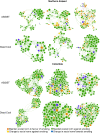Exploring the mechanistic pathways of how social network influences social norms in adolescent smoking prevention interventions
- PMID: 36810585
- PMCID: PMC9944961
- DOI: 10.1038/s41598-023-28161-7
Exploring the mechanistic pathways of how social network influences social norms in adolescent smoking prevention interventions
Abstract
We know little about how smoking prevention interventions might leverage social network structures to enhance protective social norms. In this study we combined statistical and network science methods to explore how social networks influence social norms related to adolescent smoking in school-specific settings in Northern Ireland and Colombia. Pupils (12-15 years old) participated in two smoking prevention interventions in both countries (n = 1344). A Latent Transition Analysis identified three groups characterized by descriptive and injunctive norms towards smoking. We employed a Separable Temporal Random Graph Model to analyze homophily in social norms and conducted a descriptive analysis of the changes in the students' and their friends' social norms over time to account for social influence. The results showed that students were more likely to be friends with others who had social norms against smoking. However, students with social norms favorable towards smoking had more friends with similar views than the students with perceived norms against smoking, underlining the importance of network thresholds. Our results support the notation that the ASSIST intervention takes advantage of friendship networks to leverage greater change in the students' smoking social norms than the Dead Cool intervention, reiterating that social norms are subject to social influence.
© 2023. The Author(s).
Conflict of interest statement
The authors declare no competing interests.
Figures



References
-
- World Health Organization. WHO global report on trends in prevalence of tobacco use 2000–2025. World Health Organisation (2019).
-
- Bonnie, R. J., Stratton, K. & Kwan, L. Y. Public Health Implications of Raising the Minimum Age for Purchasing Tobacco Products. (2015). - PubMed
Publication types
MeSH terms
Grants and funding
LinkOut - more resources
Full Text Sources

